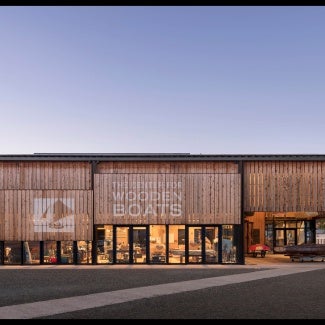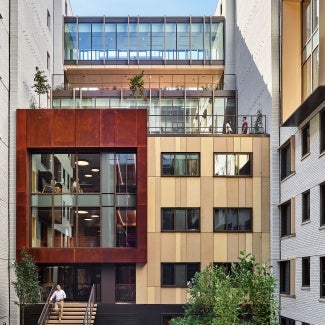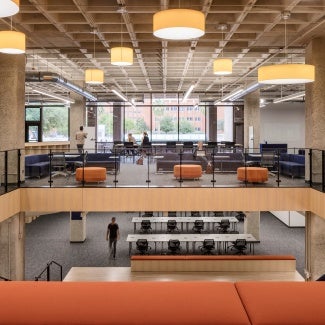Marygrove Early Education Center
The award-winning contemporary architecture of the Marygrove Early Education Center creates a state-of-the-art facility serving children up to age 5 from surrounding neighborhoods and serves as a revitalization reminder of Detroit.

Project highlights: Marygrove Early Education Center
- Architect: Marlon Blackwell Architects
- Owner: Marygrove Conservancy
- Location: Detroit
A beacon of education and a vibrant reminder of the ongoing efforts to revitalize Detroit, the Marygrove Early Education Center is a state-of-the-art facility serving children up to age 5 from surrounding neighborhoods. The center sits on Marygrove College’s campus in the city’s Livernois-McNichols District, the first new building on campus in decades. With its low-slung form and colorful exterior, it reflects the area’s newfound optimism and a pervasive spirit of new life and recovery.
The center is located just east of Marygrove’s flagship building, a four-story Tudor gothic liberal arts building originally constructed in 1927. The new building is both resonant of and deferential to the surrounding campus structures, referring to the heft of their materials and Detroit’s legacy of historic masonry structures. Clad in terra cotta, the center’s facade is a progressive application of a traditional building material. Interspersed colorful highlights, inspired by the celebrated quilts of Gee’s Bend, Alabama, give the building a second layer of articulation that reflects the energy of the children it serves and the diversity of its community.
Spreading across the site, the center’s organization forms a natural progression from the parking area at the north to a grove of existing trees to the south, where a natural play area is situated. The space between the grove and the building’s southern edge contains a garden, irrigated with water collected on-site, where fresh vegetables are grown for student meals.
Three courtyards support the center, drawing in natural light and highlighting the students’ journey from the building’s entrance to its classrooms. Resources for families and the broader community of caregivers are adjacent to the entrance. An informal gathering space for school performances, meetings, and other events sits at its core, alongside the central courtyard.
Comfortable and highly functional classrooms, designed through close collaborations with parents and teachers, run along the outside edges of the building, ensuring access to ample daylight and opportunities for outdoor play. They are color-coded by age, feature durable and sustainable materials, and boast views of the landscape. The classroom strategies support the center’s innovative curriculum in an area that has previously suffered from poor educational options.
Since its completion, the center has become an important part of the neighborhood’s transformation, helping it become a place where people want to live and stay. The early childhood education center empowers the 150 children it serves to embrace their imaginations and learn through play and creativity.
Project team & Jury
Landscape Architect: Margie Ruddick Landscape
On-site Project Representation: Intoto Studio
Engineer - Civil: Giffels Webster
Engineer - MEP: Peter Basso Associates
Engineer - Structural: SDI Structures
Lighting Design: TM Light
Early Childhood Education Planning: Heidrun Hoppe Associates
AV/IT Consultant: Commtech Design
Envelope Consultant: Studio NYL
Accessibility Review: McIntosh Group
Specifications: Amy Baker Architect
Food Service: Stephens-Bangs Associates
General Contractor: Barton Malow Builders
Ashley Wilson, FAIA, Chair, Ashley Wilson Architect, Alexandria, Va.
Jose Leo Arango, Assoc. AIA, EYP, District of Columbia
Randall Deutsch, FAIA, University of Illinois at Urbana-Champaign School of Architecture, Champaign, Ill.
Gabriel Ignacio Dziekiewicz, AIA, DesignBridge, Chicago
Teresa Jan, AIA, Multistudio, San Francisco
Luis Nieves-Ruiz, East Central Florida, Regional Planning Council, Orlando, Fla.
Zakiya Wiggins, AIA, LS3P, Raleigh, N.C.
The Architecture Award program celebrates the best contemporary architecture regardless of budget, size, style, or type. These stunning projects show the world the range of outstanding work architects create and highlight the many ways buildings and spaces can improve our lives.
Sixteen projects showcase the best contemporary architecture.













